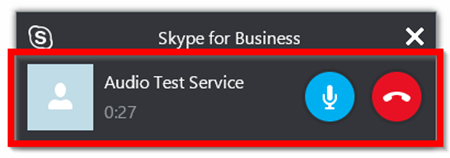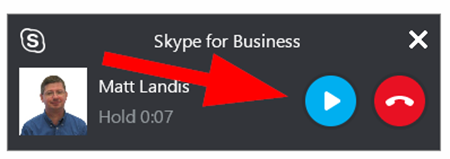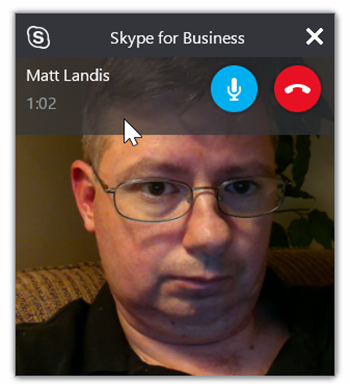CONFIGURE AUDIO/VIDEO
It is very important to understand audio configuration in Skype for Business. This will ensure that you are able to hear your phone ring, and have a good audio experience when in a call.
Select the “Audio Device Settings” option from the bottom left menu:
Ensure you have a speaker, microphone and ringer configured. Use the play buttons to test your configuration:
If you have 2 audio devices you may want to also enable the “Secondary ringer” option. This is particularly useful if your primary device is a headset, and you would like to set your PC speaker as the ringer. It is also advisable to “Unmute” when the phone rings:
If you have a camera configure this from the “Video Device” options. Select the device from the drop down menu and make sure it is working in the preview window:
ADDING CONTACTS
To add a contact to Skype for Business search for them, then right click “Add to contacts list”. Depending on your configuration Skype for Business will also display Outlook contacts:
There are different privacy levels available that determine who can see what information. To view or change the privacy level right click the contact, select “Change Privacy Relationship”, then choose from the available options:
SET UP ADDITIONAL PHONE NUMBERS
To allow your contacts to see your other phone numbers you need to add them to Skype for Business. Select the options cog from the top right:
Select “Phones” then click the phone number type you would like to add. Use the “Include in my contact card” to make it easily visible to your Skype for Business contacts:
Note: Your work phone is generally set by the administrator and cannot be changed.
PHONE SOMEONE
You can phone someone using one of the following 3 options:
- Type (or copy/paste) the phone number, and either press Enter or double-click the highlighted number
![]()
- Hover over/click the contact picture and use the phone icon
![]()
NOTE: This option will automatically call the last number you used for that contact (i.e. Skype for Business call, work number, mobile number etc)
- Reveal a list of available numbers for the contact select the arrow next to the phone icon
![]()
If you would like to leave one of your contacts a voicemail without disturbing them select the “Voicemail” option
Once the call is initiated a call window will open:
If you move away from the active call window a compact hovering window will appear so quick access to call controls. Double click to bring up the main call window again:
ANSWER AN INCOMING CALL
When you receive an incoming call a notification will pop up. Select the phone icon to answer the call:
TRANSFER A CALL
Select the “Transfer” button in the active call window:
![]()
You can select one of your own numbers, search for a contact, or type a number to transfer to:
Once you have selected the destination for the transfer, select the transfer button:
If you are transferring to a contact, and you wish to select from one of more listed numbers, right click the contact and select from the menu:
REDIRECT A CALL
When you receive an inbound call you have the option to redirect it rather than answer. You may wish that the call to goes straight to voicemail, or you may be out the door and want to redirect it to your mobile.
Select “Options” from the call notification pop up and select where you want to redirect the call:
CALL FORWARDING
There are 3 call forwarding options that can be accessed directly from the call forwarding menu at the bottom of Skype for Business:
- Turn Off Call Forwarding
- Forward Calls To
- Simultaneously Ring
For more advanced call forwarding options select “Call Forwarding Settings”:
REDIRECT UNANSWERED CALLS
By default if voicemail is enabled unanswered calls will be redirected to your voicemail box. You can change these settings from the “Call Forwarding Settings” option mentioned above.
RETRIEVE VOICEMAIL
You can retrieve your voicemail in one of 3 ways:
- Outlook - Voicemail is delivered to your Outlook inbox and can be played directly from the message
![]()
- Skype for Business - Voicemail can be retrieved from the Skype for Business client by selecting the phone tab. To play the voicemail hover over the left hand side of the message and then select the play button:
![]()
- You can also call your voicemail box using the voicemail options menu:
![]()
- Dial-in – You can dial in using any phone to the dial-in access number. You will need to know your Skype for Business number or extension, as well as your PIN. See the dial-in conferencing section below for information on how to find these details.
SET UP VOICE MAIL
Using the voicemail options menu or dial-in option above, you can call in to configure your mailbox:
![]()
The first time you call in to voicemail you will be asked to record your name and a personal greeting.
VOICEMAIL OPTIONS
Once you have accessed your Voicemail, you will be prompted to use the default voice recognition system to speak any of the following options:
PERSONAL OPTIONS
SET UP AD HOC CONFERENCE CALLS
A meeting between co-workers and other contacts is easy using Skype for Business. Simply select “Meet Now” from cog menu:
To invite people select the participant icon, then “Invite More People”:
Search people by name or phone number:
If you are planning to share content with external parties that don’t have Skype for Business, you will need to provide them the meeting link. This can be accessed from the additional options menu (…) by selecting “Meeting Entry Info”:
NOTE: For more information see the Online Meetings Guide.
DIAL-IN CONFERENCING
INTRODUCTION
Dial-in Conferencing allows you to set up and maintain your own conference room where you can invite anyone to join using Skype for Business or a standard phone.
REGISTER TO USE DIAL-IN CONFERENCING
If you intend to host or attend a conference call with external parties, you will need to set your PIN, Passcode and Conference ID in the Dial-in Conferencing system.When you dial in from a phone you will be given the chance to enter your PIN to enter as the leader.
Please note: When calling from Skype for Business you will be automatically authenticated so a PIN is not required.
To configure Dial-in Conferencing select the cog menu then “Tools” – “Dial-in Conferencing Settings”:
Click “Sign-in” and enter your Skype for Business credentials:
If this is the first time you have logged in your will be asked to create a PIN number:
Note your unique conference information and the available dial-in numbers:
Use your “Phone Number” or “Phone Extension” to identify yourself when dialing in and your PIN to authenticate:
SCHEDULE A CONFERENCE CALL
Online meetings can be scheduled using your Outlook calendar. Open a new appointment and select “Skype Meeting”:
You will see that the meeting information is automatically included in the appointment body ready for you to send:
JOIN AN ONLINE MEETING
To join a scheduled online meeting simply select the “Join Skype Meeting” link included in the appointment:
If you have Skype for Business installed the meeting will automatically start, otherwise you will be presented with options for joining the meeting. You and your participants can also dial-in using the supplied local number or by searching “Find a local number”:
When dialling in use the conference ID to enter the meeting. If you are the conference leader you will also need your PIN.
NOTE: For more information see the Online Meetings Guide.
![]()

































































































































































